Abstract
Picornaviruses are frequently implicated as the etiological agents of acute myocarditis. This association is based historically on serological evidence of rising antibody titers to specific pathogens and more recently on identification of viral genomic material in endocardial biopsy specimens through in situ hybridization. Only rarely is infectious virus isolated from either the patient or the heart during periods of maximum myocardial inflammation and injury. Thus, despite a probable viral etiology, much interest centers on the role of the immune system in cardiac damage and the likelihood that the infection triggers an autoimmune response to heart-specific antigens. Heart-reactive antibodies and T cells are found in most myocarditis patients, and immunosuppressive therapy has proven beneficial in many, though not all, cases. Furthermore, murine models of coxsackievirus group B type 3-induced myocarditis also demonstrate that virus infection initiates autoimmunity and that these autoimmune effectors are predominately responsible for tissue injury. How virus-host interactions overcome presumed self-tolerance to heart antigens is discussed, and evidence supporting various theories of virus-initiated autoimmunity and disease pathogenesis are delineated.
Full text
PDF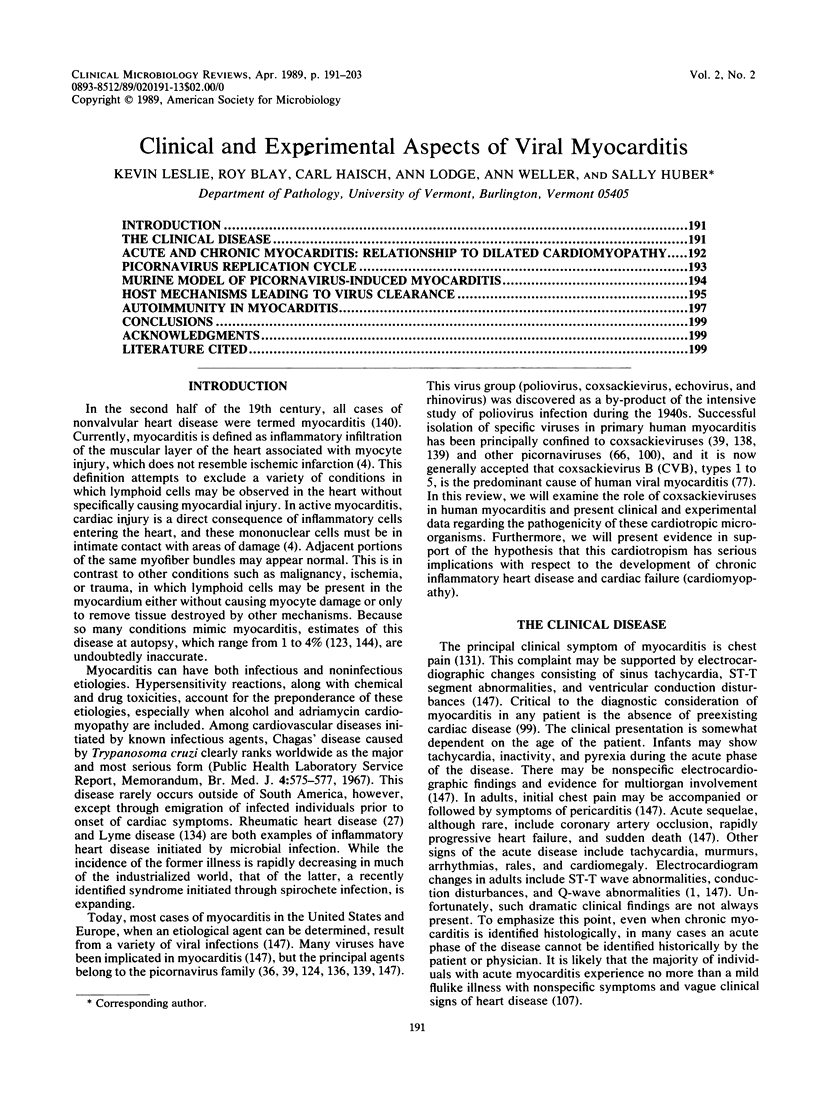
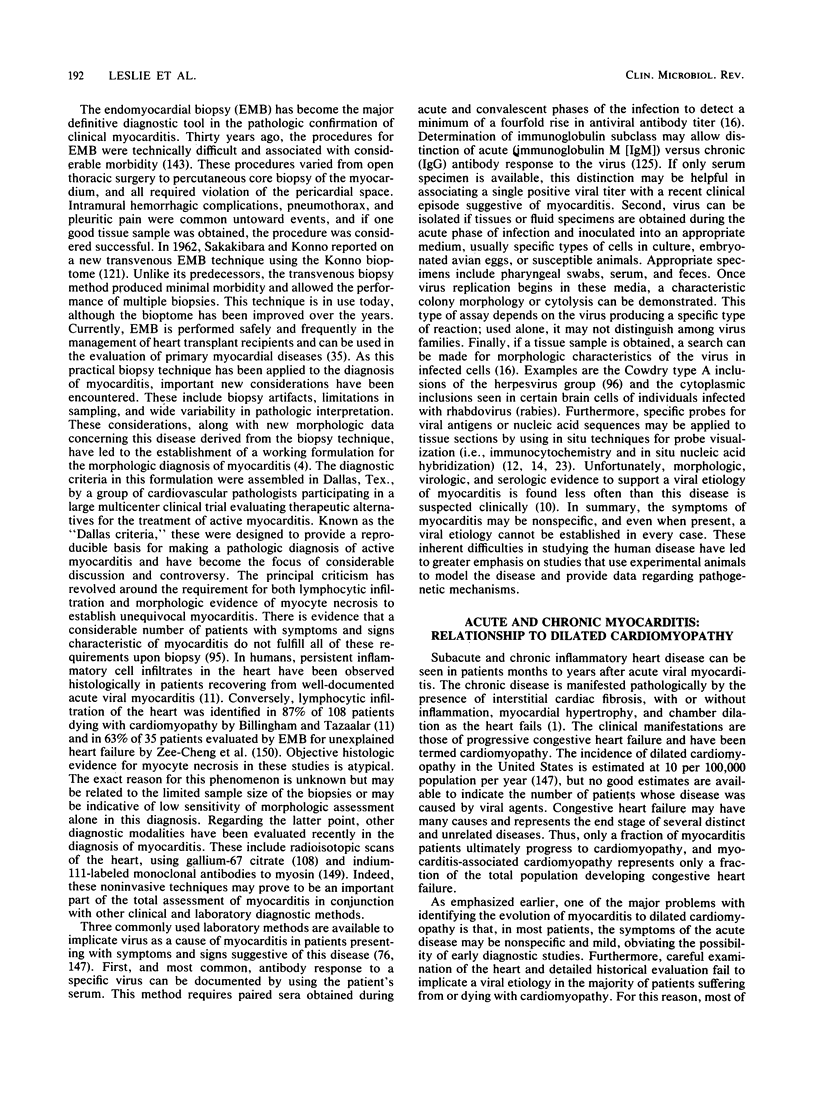
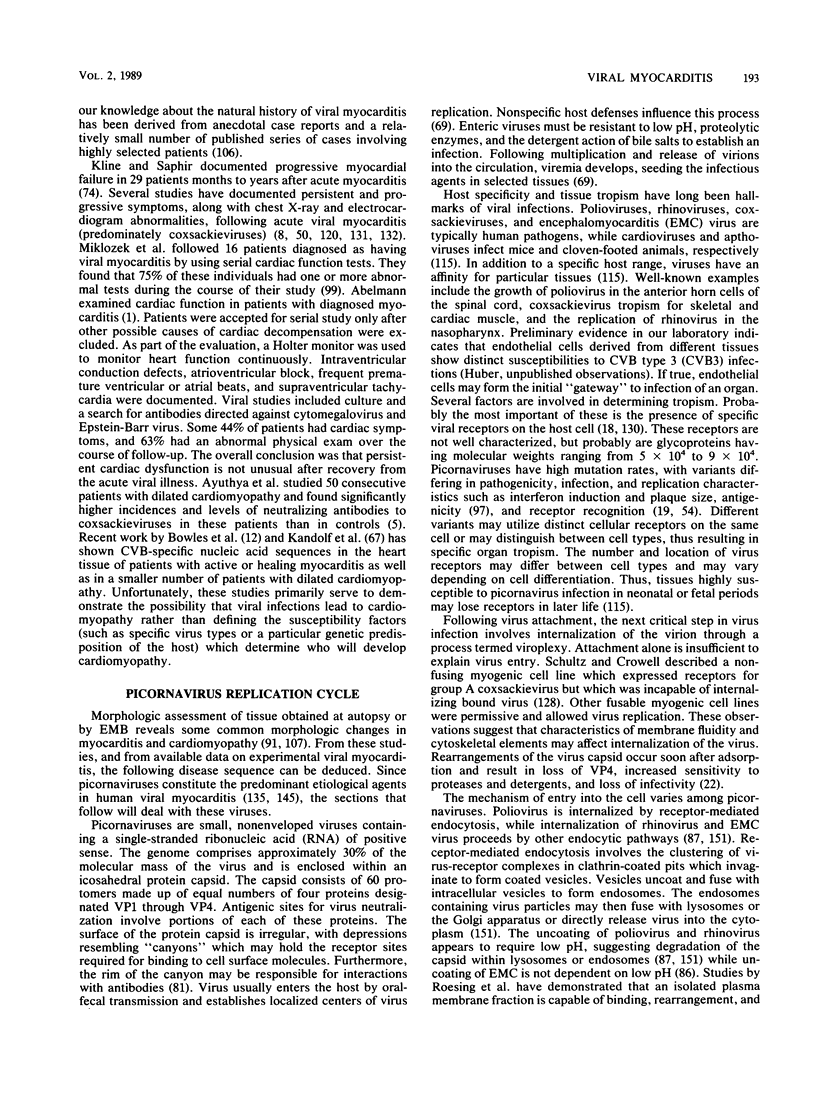
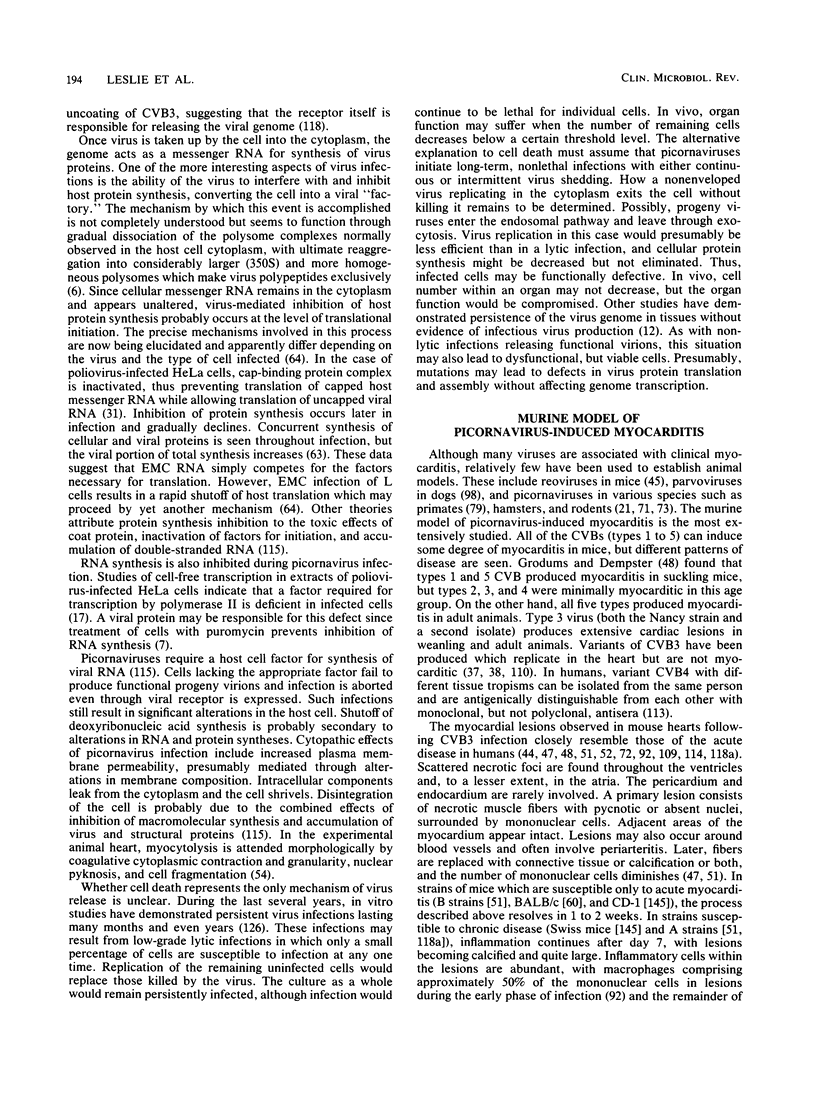
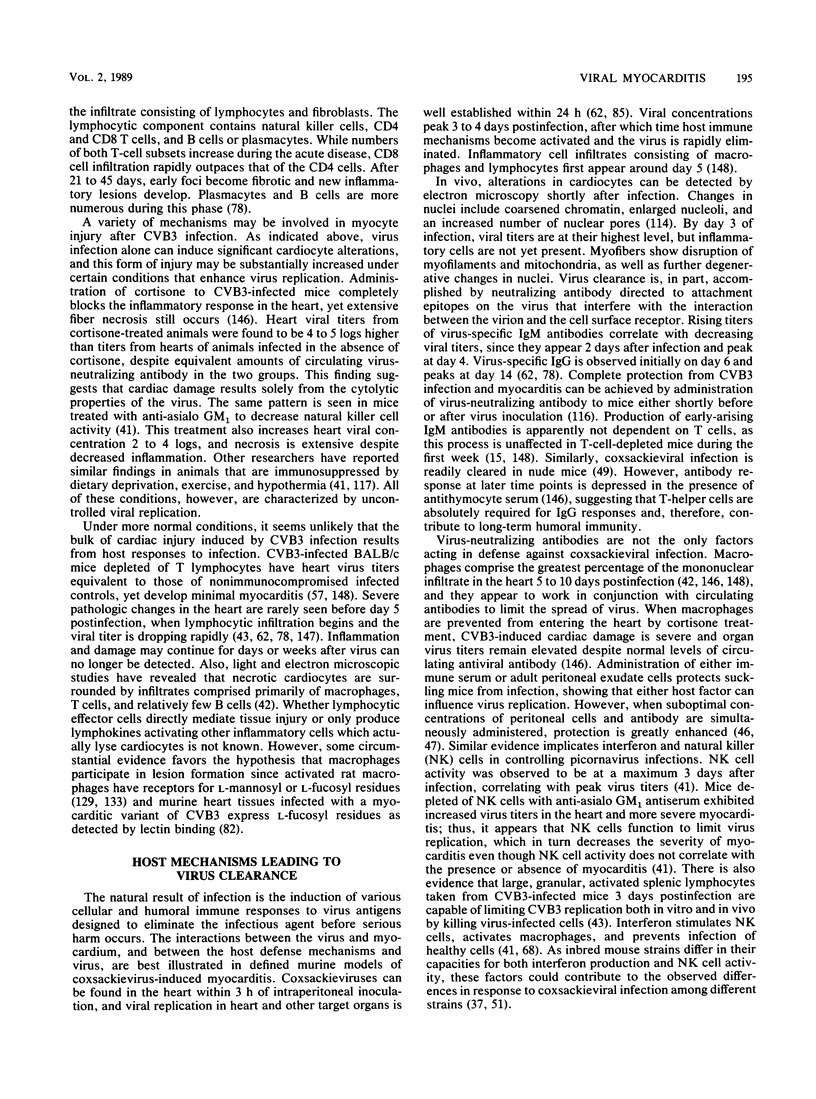
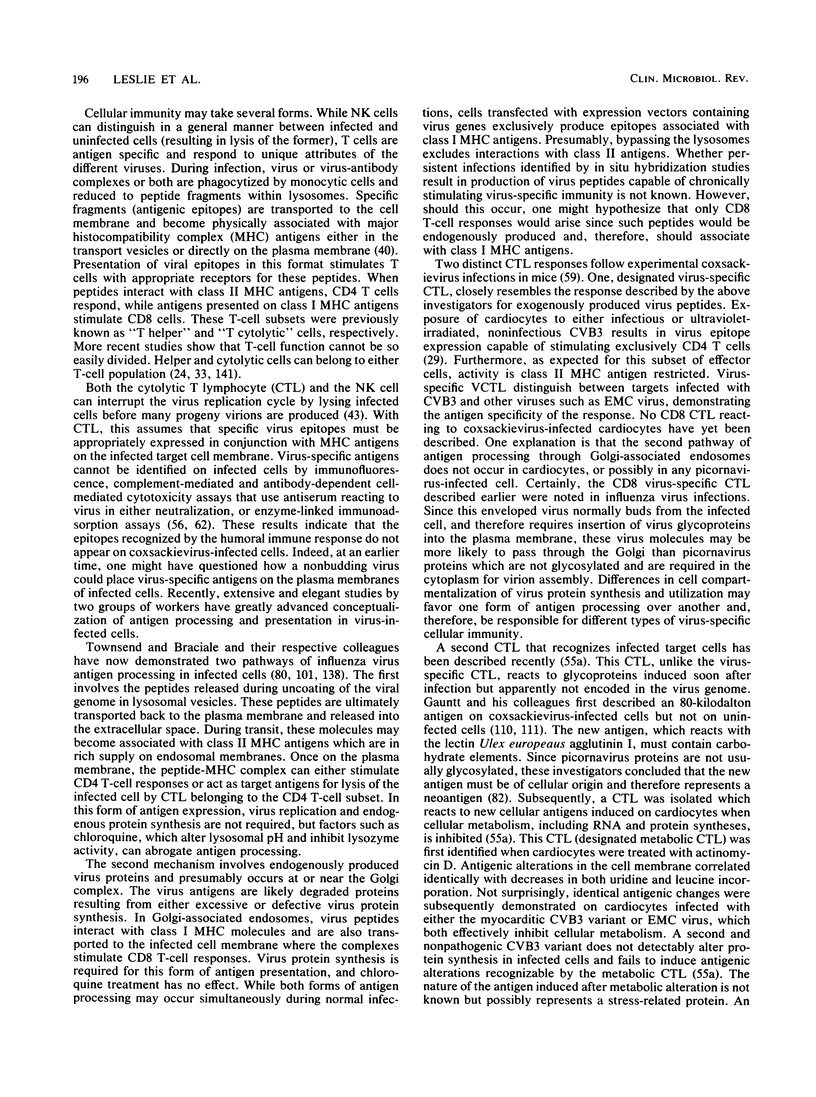
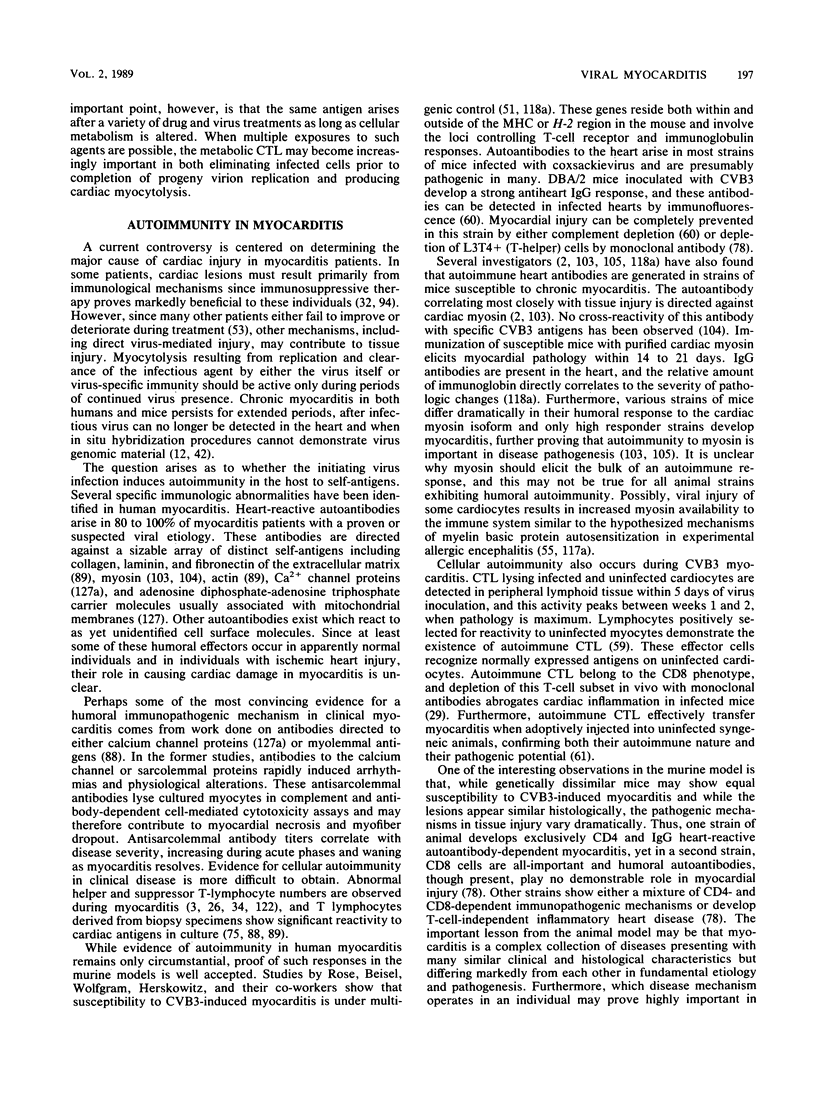
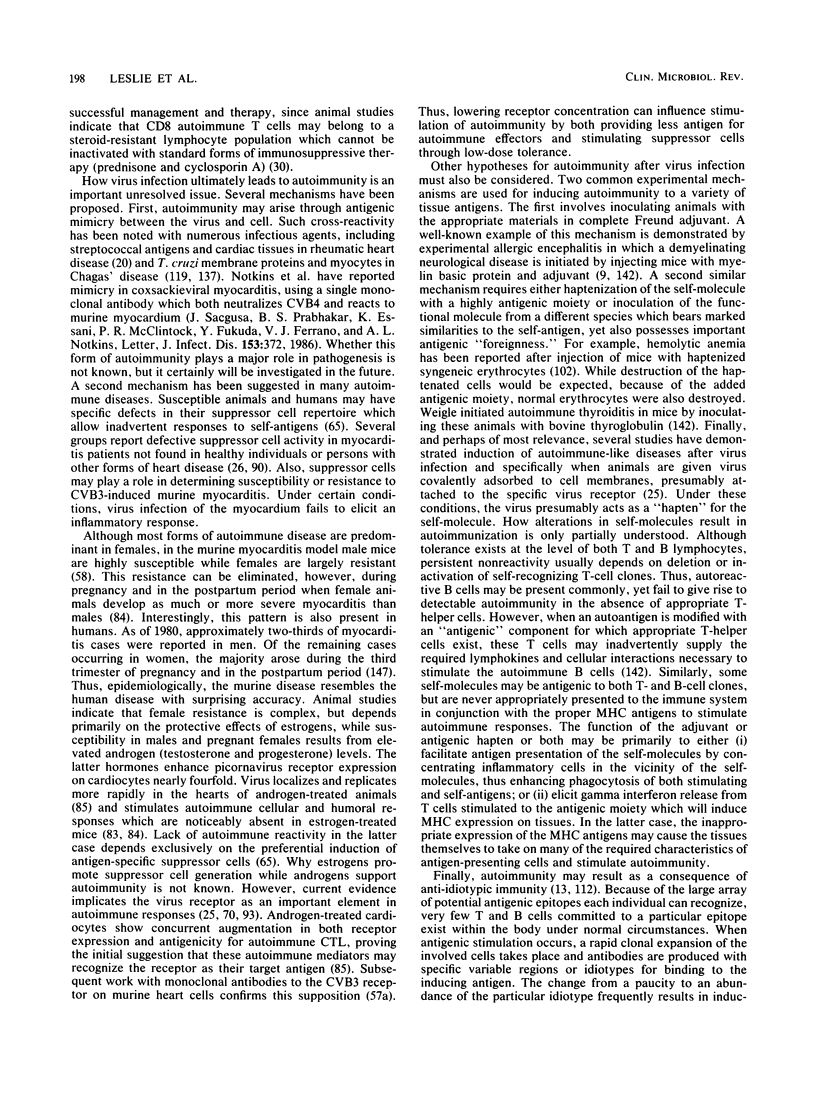
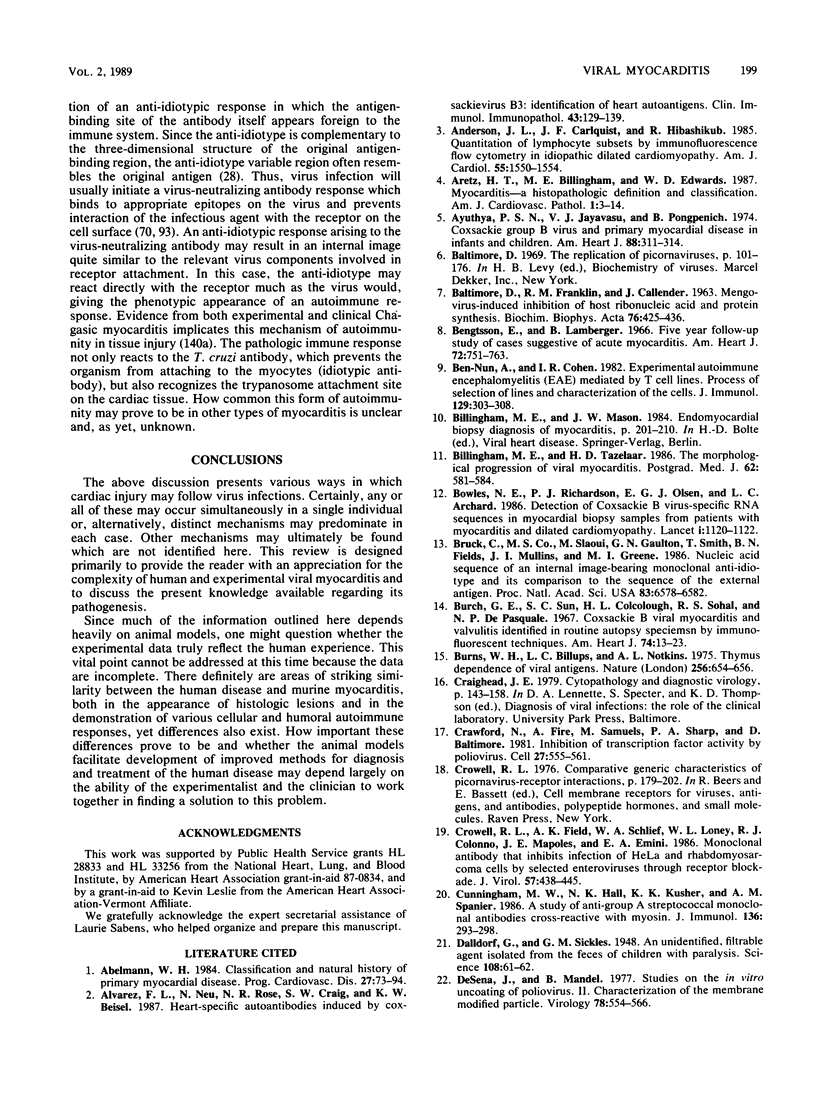
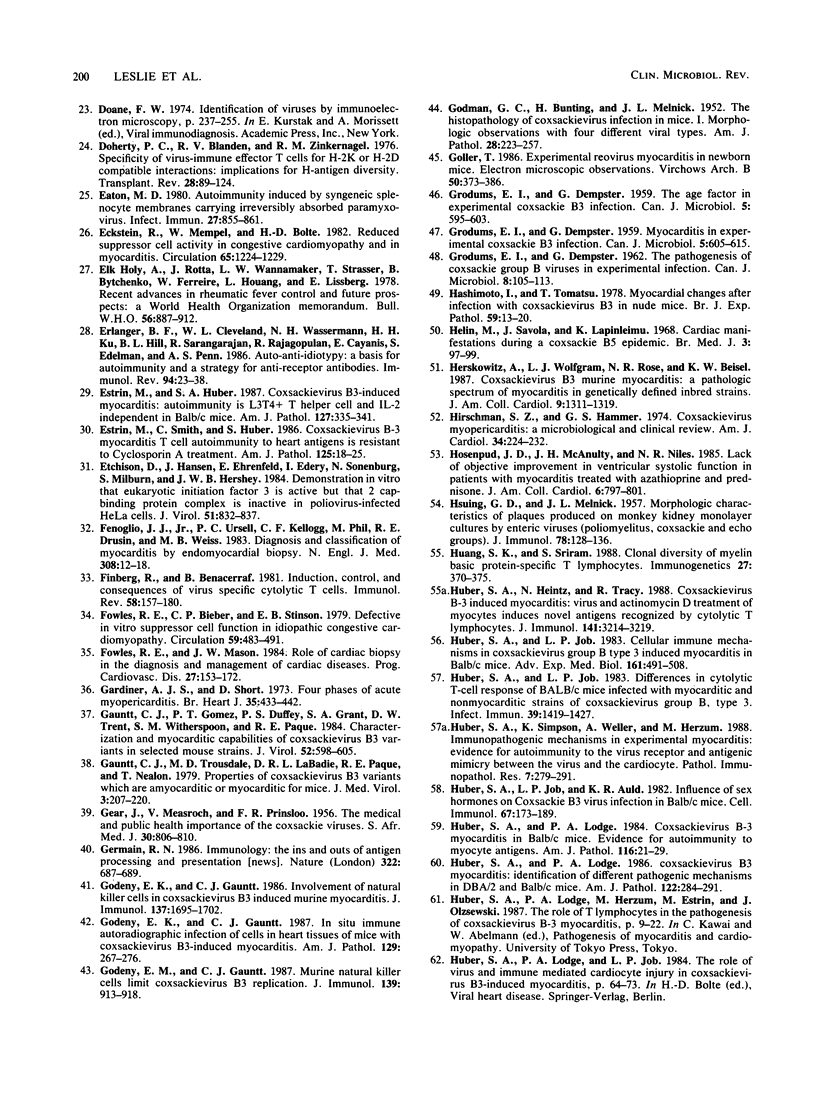
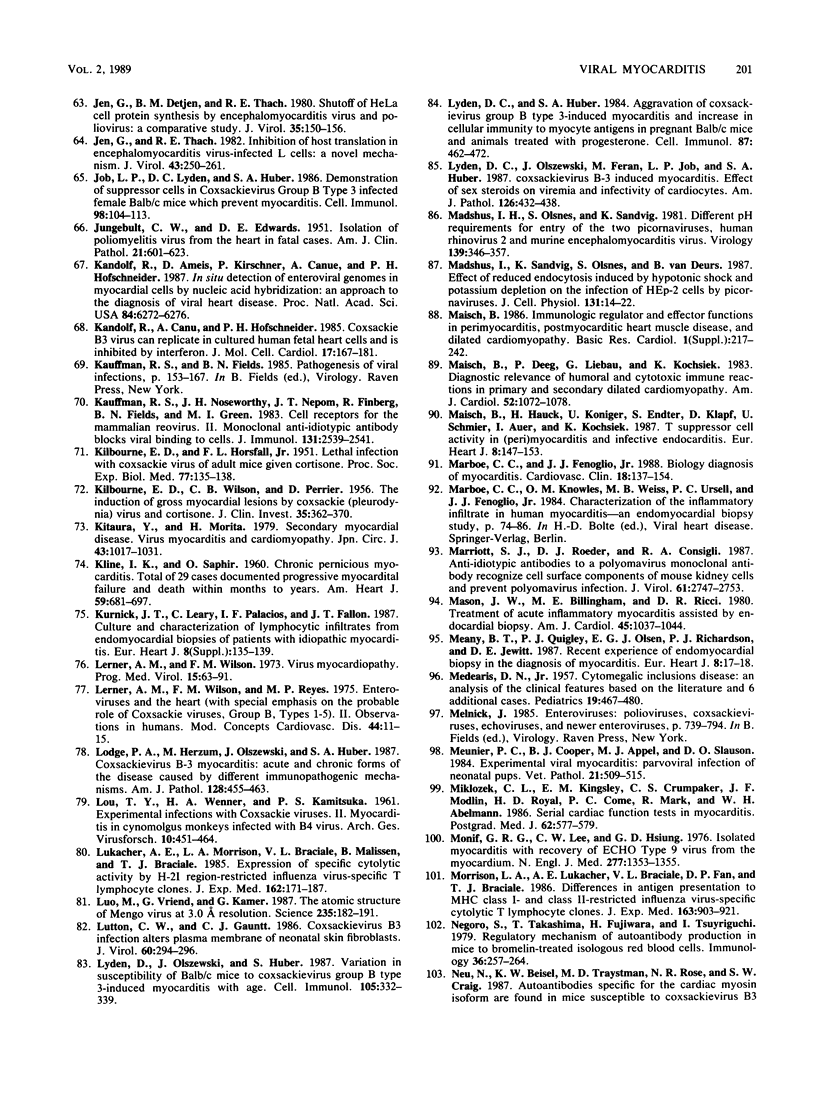
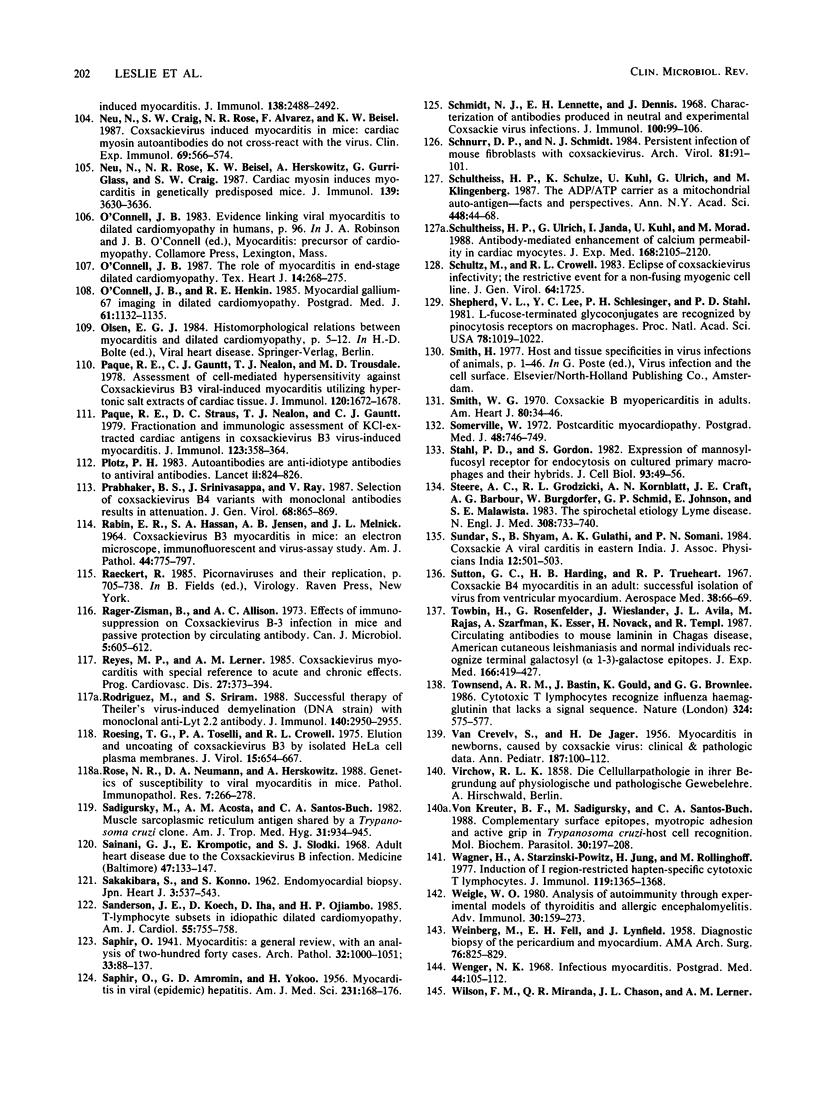
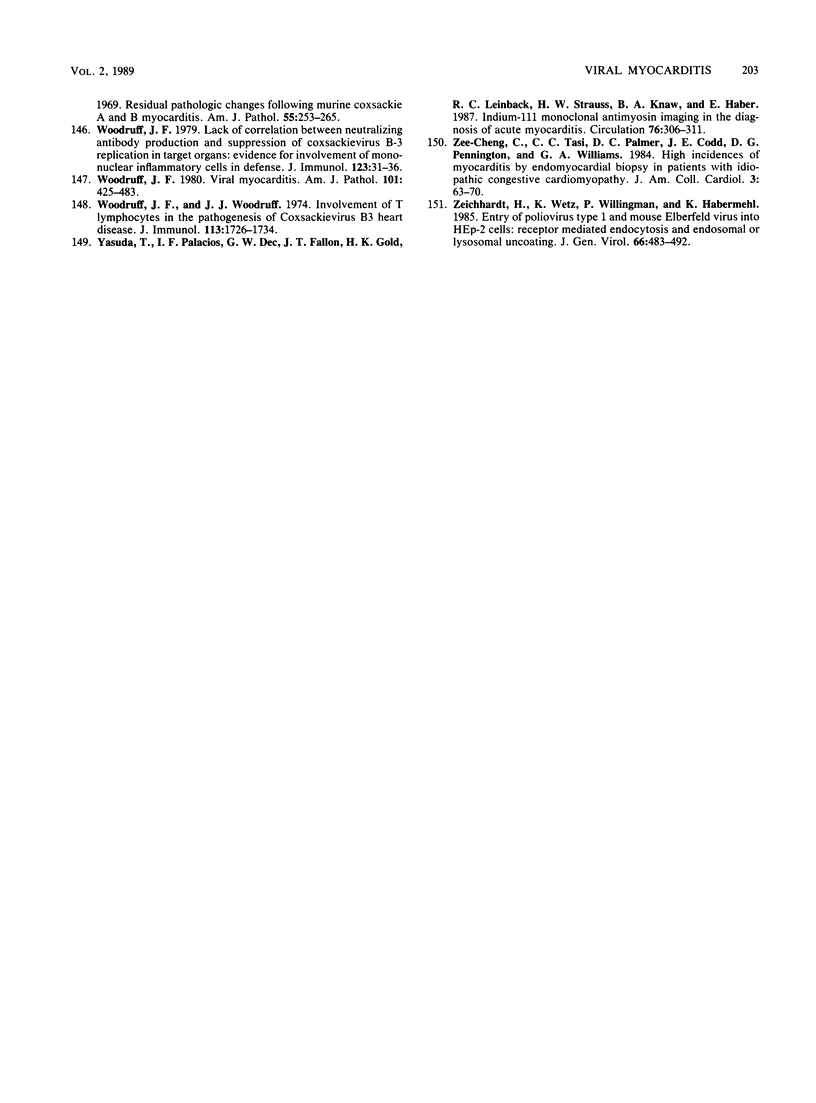
Selected References
These references are in PubMed. This may not be the complete list of references from this article.
- Abelmann W. H. Classification and natural history of primary myocardial disease. Prog Cardiovasc Dis. 1984 Sep-Oct;27(2):73–94. doi: 10.1016/0033-0620(84)90020-3. [DOI] [PubMed] [Google Scholar]
- Alvarez F. L., Neu N., Rose N. R., Craig S. W., Beisel K. W. Heart-specific autoantibodies induced by Coxsackievirus B3: identification of heart autoantigens. Clin Immunol Immunopathol. 1987 Apr;43(1):129–139. doi: 10.1016/0090-1229(87)90164-4. [DOI] [PubMed] [Google Scholar]
- Anderson J. L., Carlquist J. F., Higashikubo R. Quantitation of lymphocyte subsets by immunofluorescence flow cytometry in idiopathic dilated cardiomyopathy. Am J Cardiol. 1985 Jun 1;55(13 Pt 1):1550–1554. doi: 10.1016/0002-9149(85)90971-3. [DOI] [PubMed] [Google Scholar]
- Aretz H. T., Billingham M. E., Edwards W. D., Factor S. M., Fallon J. T., Fenoglio J. J., Jr, Olsen E. G., Schoen F. J. Myocarditis. A histopathologic definition and classification. Am J Cardiovasc Pathol. 1987 Jan;1(1):3–14. [PubMed] [Google Scholar]
- BALTIMORE D., FRANKLIN R. M., CALLENDER J. MENGOVIRUS-INDUCED INHIBITION OF HOST RIBONUCLEIC ACID AND PROTEIN SYNTHESIS. Biochim Biophys Acta. 1963 Nov 22;76:425–430. [PubMed] [Google Scholar]
- Ben-Nun A., Cohen I. R. Experimental autoimmune encephalomyelitis (EAE) mediated by T cell lines: process of selection of lines and characterization of the cells. J Immunol. 1982 Jul;129(1):303–308. [PubMed] [Google Scholar]
- Bengtsson E., Lamberger B. Five-year follow-up study of cases suggestive of acute myocarditis. Am Heart J. 1966 Dec;72(6):751–763. doi: 10.1016/0002-8703(66)90158-x. [DOI] [PubMed] [Google Scholar]
- Billingham M. E., Tazelaar H. D. The morphological progression of viral myocarditis. Postgrad Med J. 1986 Jun;62(728):581–584. doi: 10.1136/pgmj.62.728.581. [DOI] [PMC free article] [PubMed] [Google Scholar]
- Bowles N. E., Richardson P. J., Olsen E. G., Archard L. C. Detection of Coxsackie-B-virus-specific RNA sequences in myocardial biopsy samples from patients with myocarditis and dilated cardiomyopathy. Lancet. 1986 May 17;1(8490):1120–1123. doi: 10.1016/s0140-6736(86)91837-4. [DOI] [PubMed] [Google Scholar]
- Bruck C., Co M. S., Slaoui M., Gaulton G. N., Smith T., Fields B. N., Mullins J. I., Greene M. I. Nucleic acid sequence of an internal image-bearing monoclonal anti-idiotype and its comparison to the sequence of the external antigen. Proc Natl Acad Sci U S A. 1986 Sep;83(17):6578–6582. doi: 10.1073/pnas.83.17.6578. [DOI] [PMC free article] [PubMed] [Google Scholar]
- Burch G. E., Sun S. C., Colcolough H. L., Sohal R. S., DePasquale N. P. Coxsackie B viral myocarditis and valvulitis identified in routine autopsy specimens by immunofluorescent techniques. Am Heart J. 1967 Jul;74(1):13–23. doi: 10.1016/0002-8703(67)90035-x. [DOI] [PubMed] [Google Scholar]
- Burns W., Billups L. C., Notkins A. L. Thymus dependence of viral antigens. Nature. 1975 Aug 21;256(5519):654–656. doi: 10.1038/256654a0. [DOI] [PubMed] [Google Scholar]
- Crawford N., Fire A., Samuels M., Sharp P. A., Baltimore D. Inhibition of transcription factor activity by poliovirus. Cell. 1981 Dec;27(3 Pt 2):555–561. doi: 10.1016/0092-8674(81)90397-4. [DOI] [PubMed] [Google Scholar]
- Crowell R. L., Field A. K., Schleif W. A., Long W. L., Colonno R. J., Mapoles J. E., Emini E. A. Monoclonal antibody that inhibits infection of HeLa and rhabdomyosarcoma cells by selected enteroviruses through receptor blockade. J Virol. 1986 Feb;57(2):438–445. doi: 10.1128/jvi.57.2.438-445.1986. [DOI] [PMC free article] [PubMed] [Google Scholar]
- Cunningham M. W., Hall N. K., Krisher K. K., Spanier A. M. A study of anti-group A streptococcal monoclonal antibodies cross-reactive with myosin. J Immunol. 1986 Jan;136(1):293–298. [PubMed] [Google Scholar]
- DE JAGER H., VAN CREVELD S. Myocarditis in newborns, caused by coxsackie virus; clinical and pathological data. Ann Paediatr. 1956 Jul-Aug;187(1-2):100–118. [PubMed] [Google Scholar]
- Dalldorf G., Sickles G. M. An Unidentified, Filtrable Agent Isolated From the Feces of Children With Paralysis. Science. 1948 Jul 16;108(2794):61–62. doi: 10.1126/science.108.2794.61. [DOI] [PubMed] [Google Scholar]
- De Sena J., Mandel B. Studies on the in vitro uncoating of poliovirus. II. Characteristics of the membrane-modified particle. Virology. 1977 May 15;78(2):554–566. doi: 10.1016/0042-6822(77)90130-1. [DOI] [PubMed] [Google Scholar]
- Doherty P. C., Blanden R. V., Zinkernagel R. M. Specificity of virus-immune effector T cells for H-2K or H-2D compatible interactions: implications for H-antigen diversity. Transplant Rev. 1976;29:89–124. doi: 10.1111/j.1600-065x.1976.tb00198.x. [DOI] [PubMed] [Google Scholar]
- Eaton M. D. Autoimmunity induced by syngeneic splenocyte membranes carrying irreversibly adsorbed paramyxovirus. Infect Immun. 1980 Mar;27(3):855–861. doi: 10.1128/iai.27.3.855-861.1980. [DOI] [PMC free article] [PubMed] [Google Scholar]
- Eckstein R., Mempel W., Bolte H. D. Reduced suppressor cell activity in congestive cardiomyopathy and in myocarditis. Circulation. 1982 Jun;65(6):1224–1229. doi: 10.1161/01.cir.65.6.1224. [DOI] [PubMed] [Google Scholar]
- Erlanger B. F., Cleveland W. L., Wassermann N. H., Ku H. H., Hill B. L., Sarangarajan R., Rajagopalan R., Cayanis E., Edelman I. S., Penn A. S. Auto-anti-idiotype: a basis for autoimmunity and a strategy for anti-receptor antibodies. Immunol Rev. 1986 Dec;94:23–37. doi: 10.1111/j.1600-065x.1986.tb01162.x. [DOI] [PubMed] [Google Scholar]
- Estrin M., Huber S. A. Coxsackievirus B3-induced myocarditis. Autoimmunity is L3T4+ T helper cell and IL-2 independent in BALB/c mice. Am J Pathol. 1987 May;127(2):335–341. [PMC free article] [PubMed] [Google Scholar]
- Etchison D., Hansen J., Ehrenfeld E., Edery I., Sonenberg N., Milburn S., Hershey J. W. Demonstration in vitro that eucaryotic initiation factor 3 is active but that a cap-binding protein complex is inactive in poliovirus-infected HeLa cells. J Virol. 1984 Sep;51(3):832–837. doi: 10.1128/jvi.51.3.832-837.1984. [DOI] [PMC free article] [PubMed] [Google Scholar]
- Fenoglio J. J., Jr, Ursell P. C., Kellogg C. F., Drusin R. E., Weiss M. B. Diagnosis and classification of myocarditis by endomyocardial biopsy. N Engl J Med. 1983 Jan 6;308(1):12–18. doi: 10.1056/NEJM198301063080103. [DOI] [PubMed] [Google Scholar]
- Finberg R., Benacerraf B. Induction, control and consequences of virus specific cytotoxic T cells. Immunol Rev. 1981;58:157–180. doi: 10.1111/j.1600-065x.1981.tb00353.x. [DOI] [PubMed] [Google Scholar]
- Fowles R. E., Bieber C. P., Stinson E. B. Defective in vitro suppressor cell function in idiopathic congestive cardiomyopathy. Circulation. 1979 Mar;59(3):483–491. doi: 10.1161/01.cir.59.3.483. [DOI] [PubMed] [Google Scholar]
- Fowles R. E., Mason J. W. Role of cardiac biopsy in the diagnosis and management of cardiac disease. Prog Cardiovasc Dis. 1984 Nov-Dec;27(3):153–172. doi: 10.1016/0033-0620(84)90002-1. [DOI] [PubMed] [Google Scholar]
- GEAR J., MEASROCH V., PRINSLOO F. R. The medical and public health importance of the Coxsackie viruses. S Afr Med J. 1956 Aug 25;30(34):806–810. [PubMed] [Google Scholar]
- GODMAN G. C., BUNTING H., MELNICK J. L. The histopathology of Coxsackie virus infection in mice. I. Morphologic observations with four different viral types. Am J Pathol. 1952 Mar-Apr;28(2):223–257. [PMC free article] [PubMed] [Google Scholar]
- GRODUMS E. I., DEMPSTER G. Myocarditis in experimental Coxsackie B-3 infection. Can J Microbiol. 1959 Dec;5:605–615. doi: 10.1139/m59-074. [DOI] [PubMed] [Google Scholar]
- GRODUMS E. I., DEMPSTER G. The age factor in experimental Coxsackie B-3 infection. Can J Microbiol. 1959 Dec;5:595–604. doi: 10.1139/m59-073. [DOI] [PubMed] [Google Scholar]
- GRODUMS E. I., DEMPSTER G. The pathogenesis of Coxsackie group B viruses in experimental infection. Can J Microbiol. 1962 Feb;8:105–113. doi: 10.1139/m62-014. [DOI] [PubMed] [Google Scholar]
- Gardiner A. J., Short D. Four faces of acute myopericarditis. Br Heart J. 1973 Apr;35(4):433–442. doi: 10.1136/hrt.35.4.433. [DOI] [PMC free article] [PubMed] [Google Scholar]
- Gauntt C. J., Gomez P. T., Duffey P. S., Grant J. A., Trent D. W., Witherspoon S. M., Paque R. E. Characterization and myocarditic capabilities of coxsackievirus B3 variants in selected mouse strains. J Virol. 1984 Nov;52(2):598–605. doi: 10.1128/jvi.52.2.598-605.1984. [DOI] [PMC free article] [PubMed] [Google Scholar]
- Gauntt C. J., Trousdale M. D., LaBadie D. R., Paque R. E., Nealon T. Properties of coxsackievirus B3 variants which are amyocarditic or myocarditic for mice. J Med Virol. 1979;3(3):207–220. doi: 10.1002/jmv.1890030307. [DOI] [PubMed] [Google Scholar]
- Germain R. N. Immunology. The ins and outs of antigen processing and presentation. Nature. 1986 Aug 21;322(6081):687–689. doi: 10.1038/322687a0. [DOI] [PubMed] [Google Scholar]
- Godeny E. K., Gauntt C. J. In situ immune autoradiographic identification of cells in heart tissues of mice with coxsackievirus B3-induced myocarditis. Am J Pathol. 1987 Nov;129(2):267–276. [PMC free article] [PubMed] [Google Scholar]
- Godeny E. K., Gauntt C. J. Involvement of natural killer cells in coxsackievirus B3-induced murine myocarditis. J Immunol. 1986 Sep 1;137(5):1695–1702. [PubMed] [Google Scholar]
- Godeny E. K., Gauntt C. J. Murine natural killer cells limit coxsackievirus B3 replication. J Immunol. 1987 Aug 1;139(3):913–918. [PubMed] [Google Scholar]
- Göller T., Galle J., Eggers H. J., Bültmann B. Experimental reovirus myocarditis in newborn mice. Electron microscopic observations. Virchows Arch B Cell Pathol Incl Mol Pathol. 1986;50(4):373–386. doi: 10.1007/BF02889915. [DOI] [PubMed] [Google Scholar]
- HSIUNG G. D., MELNICK J. L. Morphologic characteristics of plaques produced on monkey kidney monolayer cultures by enteric viruses (poliomyelitis, Coxsackie, and echo groups. J Immunol. 1957 Feb;78(2):128–135. [PubMed] [Google Scholar]
- Haeusler G. Potential future developments in the field of antihypertensive drugs. Eur Heart J. 1987 Dec;8 (Suppl 1000):135–142. doi: 10.1093/eurheartj/8.suppl_m.135. [DOI] [PubMed] [Google Scholar]
- Hashimoto I., Komatsu T. Myocardial changes after infection with Coxsackie virus B3 in nude mice. Br J Exp Pathol. 1978 Feb;59(1):13–20. [PMC free article] [PubMed] [Google Scholar]
- Helin M., Savola J., Lapinleimu K. Cardiac manifestations during a Coxsackie B5 epidemic. Br Med J. 1968 Jul 13;3(5610):97–99. doi: 10.1136/bmj.3.5610.97. [DOI] [PMC free article] [PubMed] [Google Scholar]
- Herskowitz A., Wolfgram L. J., Rose N. R., Beisel K. W. Coxsackievirus B3 murine myocarditis: a pathologic spectrum of myocarditis in genetically defined inbred strains. J Am Coll Cardiol. 1987 Jun;9(6):1311–1319. doi: 10.1016/s0735-1097(87)80471-0. [DOI] [PubMed] [Google Scholar]
- Hirschman S. Z., Hammer G. S. Coxsackie virus myopericarditis. A microbiological and clinical review. Am J Cardiol. 1974 Aug;34(2):224–232. doi: 10.1016/0002-9149(74)90201-x. [DOI] [PubMed] [Google Scholar]
- Hosenpud J. D., McAnulty J. H., Niles N. R. Lack of objective improvement in ventricular systolic function in patients with myocarditis treated with azathioprine and prednisone. J Am Coll Cardiol. 1985 Oct;6(4):797–801. doi: 10.1016/s0735-1097(85)80485-x. [DOI] [PubMed] [Google Scholar]
- Huang S. K., Sriram S. Clonal diversity of myelin basic protein-specific T lymphocytes. Immunogenetics. 1988;27(5):370–374. doi: 10.1007/BF00395133. [DOI] [PubMed] [Google Scholar]
- Huber S. A., Heintz N., Tracy R. Coxsackievirus B-3-induced myocarditis. Virus and actinomycin D treatment of myocytes induces novel antigens recognized by cytolytic T lymphocytes. J Immunol. 1988 Nov 1;141(9):3214–3219. [PubMed] [Google Scholar]
- Huber S. A., Job L. P., Auld K. R. Influence of sex hormones on Coxsackie B-3 virus infection in Balb/c mice. Cell Immunol. 1982 Feb;67(1):173–179. doi: 10.1016/0008-8749(82)90210-6. [DOI] [PubMed] [Google Scholar]
- Huber S. A., Job L. P. Cellular immune mechanisms in Coxsackievirus group B, type 3 induced myocarditis in Balb/C mice. Adv Exp Med Biol. 1983;161:491–508. doi: 10.1007/978-1-4684-4472-8_29. [DOI] [PubMed] [Google Scholar]
- Huber S. A., Job L. P. Differences in cytolytic T cell response of BALB/c mice infected with myocarditic and non-myocarditic strains of coxsackievirus group B, type 3. Infect Immun. 1983 Mar;39(3):1419–1427. doi: 10.1128/iai.39.3.1419-1427.1983. [DOI] [PMC free article] [PubMed] [Google Scholar]
- Huber S. A., Lodge P. A. Coxsackievirus B-3 myocarditis in Balb/c mice. Evidence for autoimmunity to myocyte antigens. Am J Pathol. 1984 Jul;116(1):21–29. [PMC free article] [PubMed] [Google Scholar]
- Huber S. A., Lodge P. A. Coxsackievirus B-3 myocarditis. Identification of different pathogenic mechanisms in DBA/2 and Balb/c mice. Am J Pathol. 1986 Feb;122(2):284–291. [PMC free article] [PubMed] [Google Scholar]
- Huber S. A., Weller A., Herzum M., Lodge P. A., Estrin M., Simpson K., Guthrie M. Immunopathogenic mechanisms in experimental picornavirus-induced autoimmunity. Pathol Immunopathol Res. 1988;7(4):279–291. doi: 10.1159/000157123. [DOI] [PubMed] [Google Scholar]
- JUNGEBLUT C. W., EDWARDS J. E. Isolation of poliomyelitis virus from the heart in fatal cases. Am J Clin Pathol. 1951 Jul;21(7):601–623. doi: 10.1093/ajcp/21.7.601. [DOI] [PubMed] [Google Scholar]
- Jen G., Detjen B. M., Thach R. E. Shutoff of HeLa cell protein synthesis by encephalomyocarditis virus and poliovirus: a comparative study. J Virol. 1980 Jul;35(1):150–156. doi: 10.1128/jvi.35.1.150-156.1980. [DOI] [PMC free article] [PubMed] [Google Scholar]
- Jen G., Thach R. E. Inhibition of host translation in encephalomyocarditis virus-infected L cells: a novel mechanism. J Virol. 1982 Jul;43(1):250–261. doi: 10.1128/jvi.43.1.250-261.1982. [DOI] [PMC free article] [PubMed] [Google Scholar]
- Job L. P., Lyden D. C., Huber S. A. Demonstration of suppressor cells in coxsackievirus group B, type 3 infected female Balb/c mice which prevent myocarditis. Cell Immunol. 1986 Mar;98(1):104–113. doi: 10.1016/0008-8749(86)90271-6. [DOI] [PubMed] [Google Scholar]
- KILBOURNE E. D., HORSFALL F. L., Jr Lethal infection with coxsackie virus of adult mice given cortisone. Proc Soc Exp Biol Med. 1951 May;77(1):135–138. doi: 10.3181/00379727-77-18702. [DOI] [PubMed] [Google Scholar]
- KILBOURNE E. D., WILSON C. B., PERRIER D. The induction of gross myocardial lesions by a Coxsackie (pleurodynia) virus and cortisone. J Clin Invest. 1956 Apr;35(4):362–370. doi: 10.1172/JCI103286. [DOI] [PMC free article] [PubMed] [Google Scholar]
- KLINE I. K., SAPHIR O. Chronic pernicious myocarditis. Am Heart J. 1960 May;59:681–697. doi: 10.1016/0002-8703(60)90510-x. [DOI] [PubMed] [Google Scholar]
- Kandolf R., Ameis D., Kirschner P., Canu A., Hofschneider P. H. In situ detection of enteroviral genomes in myocardial cells by nucleic acid hybridization: an approach to the diagnosis of viral heart disease. Proc Natl Acad Sci U S A. 1987 Sep;84(17):6272–6276. doi: 10.1073/pnas.84.17.6272. [DOI] [PMC free article] [PubMed] [Google Scholar]
- Kandolf R., Canu A., Hofschneider P. H. Coxsackie B3 virus can replicate in cultured human foetal heart cells and is inhibited by interferon. J Mol Cell Cardiol. 1985 Feb;17(2):167–181. doi: 10.1016/s0022-2828(85)80019-5. [DOI] [PubMed] [Google Scholar]
- Kauffman R. S., Noseworthy J. H., Nepom J. T., Finberg R., Fields B. N., Greene M. I. Cell receptors for the mammalian reovirus. II. Monoclonal anti-idiotypic antibody blocks viral binding to cells. J Immunol. 1983 Nov;131(5):2539–2541. [PubMed] [Google Scholar]
- Kitaura Y., Morita H. Secondary myocardial disease. Virus myocarditis and cardiomyopathy. Jpn Circ J. 1979 Nov;43(11):1017–1031. doi: 10.1253/jcj.43.1017. [DOI] [PubMed] [Google Scholar]
- LOU T. Y., WENNER H. A., KAMITSUKA P. S. Experimental infections with Coxackie viruses. II. Myocarditis in Cynomolgus monkeys infected with B 4 virus. Arch Gesamte Virusforsch. 1961;10:451–464. [PubMed] [Google Scholar]
- Lerner A. M., Wilson F. M. Virus myocardiopathy. Prog Med Virol. 1973;15:63–91. [PubMed] [Google Scholar]
- Lerner A., Wilson F. M., Reyes M. P. Enteroviruses and the heart (with special emphasis on the probable role of coxsackieviruses, group B, types 1-5). II. Observations in humans. Mod Concepts Cardiovasc Dis. 1975 Mar;44(3):11–15. [PubMed] [Google Scholar]
- Lodge P. A., Herzum M., Olszewski J., Huber S. A. Coxsackievirus B-3 myocarditis. Acute and chronic forms of the disease caused by different immunopathogenic mechanisms. Am J Pathol. 1987 Sep;128(3):455–463. [PMC free article] [PubMed] [Google Scholar]
- Lukacher A. E., Morrison L. A., Braciale V. L., Malissen B., Braciale T. J. Expression of specific cytolytic activity by H-2I region-restricted, influenza virus-specific T lymphocyte clones. J Exp Med. 1985 Jul 1;162(1):171–187. doi: 10.1084/jem.162.1.171. [DOI] [PMC free article] [PubMed] [Google Scholar]
- Luo M., Vriend G., Kamer G., Minor I., Arnold E., Rossmann M. G., Boege U., Scraba D. G., Duke G. M., Palmenberg A. C. The atomic structure of Mengo virus at 3.0 A resolution. Science. 1987 Jan 9;235(4785):182–191. doi: 10.1126/science.3026048. [DOI] [PubMed] [Google Scholar]
- Lutton C. W., Gauntt C. J. Coxsackievirus B3 infection alters plasma membrane of neonatal skin fibroblasts. J Virol. 1986 Oct;60(1):294–296. doi: 10.1128/jvi.60.1.294-296.1986. [DOI] [PMC free article] [PubMed] [Google Scholar]
- Lyden D. C., Huber S. A. Aggravation of coxsackievirus, group B, type 3-induced myocarditis and increase in cellular immunity to myocyte antigens in pregnant Balb/c mice and animals treated with progesterone. Cell Immunol. 1984 Sep;87(2):462–472. doi: 10.1016/0008-8749(84)90015-7. [DOI] [PubMed] [Google Scholar]
- Lyden D. C., Olszewski J., Feran M., Job L. P., Huber S. A. Coxsackievirus B-3-induced myocarditis. Effect of sex steroids on viremia and infectivity of cardiocytes. Am J Pathol. 1987 Mar;126(3):432–438. [PMC free article] [PubMed] [Google Scholar]
- Lyden D., Olszewski J., Huber S. Variation in susceptibility of Balb/c mice to coxsackievirus group B type 3-induced myocarditis with age. Cell Immunol. 1987 Apr 1;105(2):332–339. doi: 10.1016/0008-8749(87)90081-5. [DOI] [PubMed] [Google Scholar]
- MEDEARIS D. N., Jr Cytomegalic inclusion disease; an analysis of the clinical features based on the literature and six additional cases. Pediatrics. 1957 Mar;19(3):467–480. [PubMed] [Google Scholar]
- Madshus I. H., Olsnes S., Sandvig K. Different pH requirements for entry of the two picornaviruses, human rhinovirus 2 and murine encephalomyocarditis virus. Virology. 1984 Dec;139(2):346–357. doi: 10.1016/0042-6822(84)90380-5. [DOI] [PubMed] [Google Scholar]
- Madshus I. H., Sandvig K., Olsnes S., van Deurs B. Effect of reduced endocytosis induced by hypotonic shock and potassium depletion on the infection of Hep 2 cells by picornaviruses. J Cell Physiol. 1987 Apr;131(1):14–22. doi: 10.1002/jcp.1041310104. [DOI] [PubMed] [Google Scholar]
- Maisch B., Deeg P., Liebau G., Kochsiek K. Diagnostic relevance of humoral and cytotoxic immune reactions in primary and secondary dilated cardiomyopathy. Am J Cardiol. 1983 Nov 1;52(8):1072–1078. doi: 10.1016/0002-9149(83)90535-0. [DOI] [PubMed] [Google Scholar]
- Maisch B. Immunologic regulator and effector functions in perimyocarditis, postmyocarditic heart muscle disease and dilated cardiomyopathy. Basic Res Cardiol. 1986;81 (Suppl 1):217–241. doi: 10.1007/978-3-662-11374-5_21. [DOI] [PubMed] [Google Scholar]
- Marboe C. C., Fenoglio J. J., Jr Biopsy diagnosis of myocarditis. Cardiovasc Clin. 1988;18(2):137–154. [PubMed] [Google Scholar]
- Marriott S. J., Roeder D. J., Consigli R. A. Anti-idiotypic antibodies to a polyomavirus monoclonal antibody recognize cell surface components of mouse kidney cells and prevent polyomavirus infection. J Virol. 1987 Sep;61(9):2747–2753. doi: 10.1128/jvi.61.9.2747-2753.1987. [DOI] [PMC free article] [PubMed] [Google Scholar]
- Mason J. W., Billingham M. E., Ricci D. R. Treatment of acute inflammatory myocarditis assisted by endomyocardial biopsy. Am J Cardiol. 1980 May;45(5):1037–1044. doi: 10.1016/0002-9149(80)90174-5. [DOI] [PubMed] [Google Scholar]
- Meunier P. C., Cooper B. J., Appel M. J., Slauson D. O. Experimental viral myocarditis: parvoviral infection of neonatal pups. Vet Pathol. 1984 Sep;21(5):509–515. doi: 10.1177/030098588402100510. [DOI] [PubMed] [Google Scholar]
- Miklozek C. L., Kingsley E. M., Crumpaker C. S., Modlin J. F., Royal H. D., Come P. C., Mark R., Abelmann W. H. Serial cardiac function tests in myocarditis. Postgrad Med J. 1986 Jun;62(728):577–579. doi: 10.1136/pgmj.62.728.577. [DOI] [PMC free article] [PubMed] [Google Scholar]
- Monif G. R., Lee C. W., Hsiung G. D. Isolated myocarditis with recovery of ECHO type 9 virus from the myocardium. N Engl J Med. 1967 Dec 21;277(25):1353–1355. doi: 10.1056/NEJM196712212772506. [DOI] [PubMed] [Google Scholar]
- Morrison L. A., Lukacher A. E., Braciale V. L., Fan D. P., Braciale T. J. Differences in antigen presentation to MHC class I-and class II-restricted influenza virus-specific cytolytic T lymphocyte clones. J Exp Med. 1986 Apr 1;163(4):903–921. doi: 10.1084/jem.163.4.903. [DOI] [PMC free article] [PubMed] [Google Scholar]
- Negoro S., Takashima T., Fujiwara H., Tsuyuguchi I. Regulatory mechanism of autoantibody production in mice to bromelin-treated isologous red blood cells. Immunology. 1979 Feb;36(2):257–264. [PMC free article] [PubMed] [Google Scholar]
- Neu N., Craig S. W., Rose N. R., Alvarez F., Beisel K. W. Coxsackievirus induced myocarditis in mice: cardiac myosin autoantibodies do not cross-react with the virus. Clin Exp Immunol. 1987 Sep;69(3):566–574. [PMC free article] [PubMed] [Google Scholar]
- Neu N., Rose N. R., Beisel K. W., Herskowitz A., Gurri-Glass G., Craig S. W. Cardiac myosin induces myocarditis in genetically predisposed mice. J Immunol. 1987 Dec 1;139(11):3630–3636. [PubMed] [Google Scholar]
- O'Connell J. B. The role of myocarditis in end-stage dilated cardiomyopathy. Tex Heart Inst J. 1987 Sep;14(3):268–275. [PMC free article] [PubMed] [Google Scholar]
- Paque R. E., Gauntt C. J., Nealon T. J., Trousdale M. D. Assessment of cell-mediated hypersensitivity against coxsackievirus B3 viral-induced myocarditis utilizing hypertonic salt extracts of cardiac tissue. J Immunol. 1978 May;120(5):1672–1678. [PubMed] [Google Scholar]
- Paque R. E., Straus D. C., Nealon T. J., Gauntt C. J. Fractionation and immunologic assessment of KCl-extracted cardiac antigens in coxsackievirus B3 virus-induced myocarditis. J Immunol. 1979 Jul;123(1):358–364. [PubMed] [Google Scholar]
- Plotz P. H. Autoantibodies are anti-idiotype antibodies to antiviral antibodies. Lancet. 1983 Oct 8;2(8354):824–826. doi: 10.1016/s0140-6736(83)90740-7. [DOI] [PubMed] [Google Scholar]
- Prabhakar B. S., Srinivasappa J., Ray U. Selection of coxsackievirus B4 variants with monoclonal antibodies results in attenuation. J Gen Virol. 1987 Mar;68(Pt 3):865–869. doi: 10.1099/0022-1317-68-3-865. [DOI] [PubMed] [Google Scholar]
- RABIN E. R., HASSAN S. A., JENSON A. B., MELNICK J. L. COXSACKIE VIRUS B3 MYOCARDITIS IN MICE. AN ELECTRON MICROSCOPIC, IMMUNOFLUORESCENT AND VIRUS-ASSAY STUDY. Am J Pathol. 1964 May;44:775–797. [PMC free article] [PubMed] [Google Scholar]
- Reyes M. P., Lerner A. M. Coxsackievirus myocarditis--with special reference to acute and chronic effects. Prog Cardiovasc Dis. 1985 May-Jun;27(6):373–394. doi: 10.1016/0033-0620(85)90001-5. [DOI] [PubMed] [Google Scholar]
- Rodriguez M., Sriram S. Successful therapy of Theiler's virus-induced demyelination (DA strain) with monoclonal anti-Lyt-2 antibody. J Immunol. 1988 May 1;140(9):2950–2955. [PubMed] [Google Scholar]
- Roesing T. G., Toselli P. A., Crowell R. L. Elution and uncoating of Coxsackievirus B3 by isolated HeLa cell plasma membranes. J Virol. 1975 Mar;15(3):654–657. doi: 10.1128/jvi.15.3.654-657.1975. [DOI] [PMC free article] [PubMed] [Google Scholar]
- Rose N. R., Neumann D. A., Herskowitz A., Traystman M. D., Beisel K. W. Genetics of susceptibility to viral myocarditis in mice. Pathol Immunopathol Res. 1988;7(4):266–278. doi: 10.1159/000157122. [DOI] [PubMed] [Google Scholar]
- SAKAKIBARA S., KONNO S. Endomyocardial biopsy. Jpn Heart J. 1962 Nov;3:537–543. doi: 10.1536/ihj.3.537. [DOI] [PubMed] [Google Scholar]
- SAPHIR O., AMROMIN G. D., YOKOO H. Myocarditis in viral (epidemic) hepatitis. Am J Med Sci. 1956 Feb;231(2):168–176. [PubMed] [Google Scholar]
- Sadigursky M., Acosta A. M., Santos-Buch C. A. Muscle sarcoplasmic reticulum antigen shared by a Trypanosoma cruzi clone. Am J Trop Med Hyg. 1982 Sep;31(5):934–941. doi: 10.4269/ajtmh.1982.31.934. [DOI] [PubMed] [Google Scholar]
- Sainani G. S., Krompotic E., Slodki S. J. Adult heart disease due to the Coxsackie virus B infection. Medicine (Baltimore) 1968 Mar;47(2):133–147. doi: 10.1097/00005792-196803000-00003. [DOI] [PubMed] [Google Scholar]
- Sanderson J. E., Koech D., Iha D., Ojiambo H. P. T-lymphocyte subsets in idiopathic dilated cardiomyopathy. Am J Cardiol. 1985 Mar 1;55(6):755–758. doi: 10.1016/0002-9149(85)90151-1. [DOI] [PubMed] [Google Scholar]
- Schmidt N. J., Lennette E. H., Dennis J. Characterization of antibodies produced in natural and experimental coxsackievirus infections. J Immunol. 1968 Jan;100(1):99–106. [PubMed] [Google Scholar]
- Schnurr D. P., Schmidt N. J. Persistent infection of mouse fibroblasts with Coxsackievirus. Arch Virol. 1984;81(1-2):91–101. doi: 10.1007/BF01309299. [DOI] [PubMed] [Google Scholar]
- Schultheiss H. P., Kühl U., Janda I., Melzner B., Ulrich G., Morad M. Antibody-mediated enhancement of calcium permeability in cardiac myocytes. J Exp Med. 1988 Dec 1;168(6):2105–2119. doi: 10.1084/jem.168.6.2105. [DOI] [PMC free article] [PubMed] [Google Scholar]
- Schultz M., Crowell R. L. Eclipse of coxsackievirus infectivity: the restrictive event for a non-fusing myogenic cell line. J Gen Virol. 1983 Aug;64(Pt 8):1725–1734. doi: 10.1099/0022-1317-64-8-1725. [DOI] [PubMed] [Google Scholar]
- Shepherd V. L., Lee Y. C., Schlesinger P. H., Stahl P. D. L-Fucose-terminated glycoconjugates are recognized by pinocytosis receptors on macrophages. Proc Natl Acad Sci U S A. 1981 Feb;78(2):1019–1022. doi: 10.1073/pnas.78.2.1019. [DOI] [PMC free article] [PubMed] [Google Scholar]
- Smith W. G. Coxsackie B myopericarditis in adults. Am Heart J. 1970 Jul;80(1):34–46. doi: 10.1016/0002-8703(70)90035-9. [DOI] [PubMed] [Google Scholar]
- Somerville W. Postcarditic myocardiopathy. Postgrad Med J. 1972 Dec;48(566):746–749. doi: 10.1136/pgmj.48.566.746. [DOI] [PMC free article] [PubMed] [Google Scholar]
- Stahl P., Gordon S. Expression of a mannosyl-fucosyl receptor for endocytosis on cultured primary macrophages and their hybrids. J Cell Biol. 1982 Apr;93(1):49–56. doi: 10.1083/jcb.93.1.49. [DOI] [PMC free article] [PubMed] [Google Scholar]
- Steere A. C., Grodzicki R. L., Kornblatt A. N., Craft J. E., Barbour A. G., Burgdorfer W., Schmid G. P., Johnson E., Malawista S. E. The spirochetal etiology of Lyme disease. N Engl J Med. 1983 Mar 31;308(13):733–740. doi: 10.1056/NEJM198303313081301. [DOI] [PubMed] [Google Scholar]
- Sudhas-Na-Ayuthya P., Jayavasu J., Pongpanich B. Coxsackie group B virus and primary myocardial disease in infants and children. Am Heart J. 1974 Sep;88(3):311–314. doi: 10.1016/0002-8703(74)90464-5. [DOI] [PubMed] [Google Scholar]
- Sundar S., Shyam B., Gulathi A. K., Somani P. N. Coxsackie--a viral carditis in eastern India. J Assoc Physicians India. 1984 Jun;32(6):501–503. [PubMed] [Google Scholar]
- Towbin H., Rosenfelder G., Wieslander J., Avila J. L., Rojas M., Szarfman A., Esser K., Nowack H., Timpl R. Circulating antibodies to mouse laminin in Chagas disease, American cutaneous leishmaniasis, and normal individuals recognize terminal galactosyl(alpha 1-3)-galactose epitopes. J Exp Med. 1987 Aug 1;166(2):419–432. doi: 10.1084/jem.166.2.419. [DOI] [PMC free article] [PubMed] [Google Scholar]
- Townsend A. R., Bastin J., Gould K., Brownlee G. G. Cytotoxic T lymphocytes recognize influenza haemagglutinin that lacks a signal sequence. Nature. 1986 Dec 11;324(6097):575–577. doi: 10.1038/324575a0. [DOI] [PubMed] [Google Scholar]
- WEINBERG M., FELL E. H., LYNFIELD J. Diagnostic biopsy of the pericardium and myocardium. AMA Arch Surg. 1958 May;76(5):825–829. doi: 10.1001/archsurg.1958.01280230165025. [DOI] [PubMed] [Google Scholar]
- Wagner H., Starzinski-Powitz A., Jung H., Röllinghoff M. Induction of I region-restricted hapten-specific cytotoxic T lymphocytes. J Immunol. 1977 Oct;119(4):1365–1368. [PubMed] [Google Scholar]
- Weigle W. O. Analysis of autoimmunity through experimental models of thyroiditis and allergic encephalomyelitis. Adv Immunol. 1980;30:159–273. doi: 10.1016/s0065-2776(08)60196-0. [DOI] [PubMed] [Google Scholar]
- Wenger N. K. Infectious myocarditis. Postgrad Med. 1968 Sep;44(3):105–112. doi: 10.1080/00325481.1968.11693383. [DOI] [PubMed] [Google Scholar]
- Woodruff J. F. Lack of correlation between neutralizing antibody production and suppression of coxsackievirus B-3 replication in target organs: evidence for involvement of mononuclear inflammatory cells in host defense. J Immunol. 1979 Jul;123(1):31–36. [PubMed] [Google Scholar]
- Woodruff J. F. Viral myocarditis. A review. Am J Pathol. 1980 Nov;101(2):425–484. [PMC free article] [PubMed] [Google Scholar]
- Woodruff J. F., Woodruff J. J. Involvement of T lymphocytes in the pathogenesis of coxsackie virus B3 heart disease. J Immunol. 1974 Dec;113(6):1726–1734. [PubMed] [Google Scholar]
- Yasuda T., Palacios I. F., Dec G. W., Fallon J. T., Gold H. K., Leinbach R. C., Strauss H. W., Khaw B. A., Haber E. Indium 111-monoclonal antimyosin antibody imaging in the diagnosis of acute myocarditis. Circulation. 1987 Aug;76(2):306–311. doi: 10.1161/01.cir.76.2.306. [DOI] [PubMed] [Google Scholar]
- Zee-Cheng C. S., Tsai C. C., Palmer D. C., Codd J. E., Pennington D. G., Williams G. A. High incidence of myocarditis by endomyocardial biopsy in patients with idiopathic congestive cardiomyopathy. J Am Coll Cardiol. 1984 Jan;3(1):63–70. doi: 10.1016/s0735-1097(84)80431-3. [DOI] [PubMed] [Google Scholar]
- Zeichhardt H., Wetz K., Willingmann P., Habermehl K. O. Entry of poliovirus type 1 and Mouse Elberfeld (ME) virus into HEp-2 cells: receptor-mediated endocytosis and endosomal or lysosomal uncoating. J Gen Virol. 1985 Mar;66(Pt 3):483–492. doi: 10.1099/0022-1317-66-3-483. [DOI] [PubMed] [Google Scholar]
- von Kreuter B. F., Sadigursky M., Santos-Buch C. A. Complementary surface epitopes, myotropic adhesion and active grip in Trypanosoma cruzi-host cell recognition. Mol Biochem Parasitol. 1988 Sep;30(3):197–208. doi: 10.1016/0166-6851(88)90088-6. [DOI] [PubMed] [Google Scholar]


